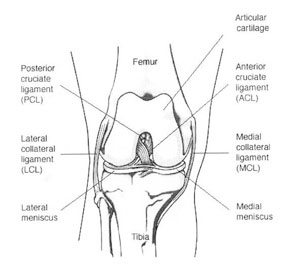The anatomy of the knee is made up of three bones:
In addition to these bones, the knee is supported and controlled by several muscles and ligaments that help create normal motion and protect the knee from damage.
While the medial collateral ligament (MCL) and lateral collateral ligament (LCL) help to stabilize the knee from side-to-side motions, the anterior cruciate ligament (ACL) and posterior cruciate ligament (PCL) function together to support the knee during normal activities and sports by protecting it from front-to-back movement. All four of these ligaments work together in harmony to ensure that proper unloading takes places within the joint, and that the weight is evenly distributed throughout.
Another important component of the anatomy of the knee is the articular cartilage. This is a smooth lining that covers the end of the knee bones, and which acts as a shock absorber, allowing the knee to perform movements and motions. When the weight of the knee is evenly distributed, the articular cartilage is protected. In addition to cartilage, the knee also contains two very important structures known as the medial and the lateral menisci. The menisci reside on either side of the knee joint acting as shock absorbers.

